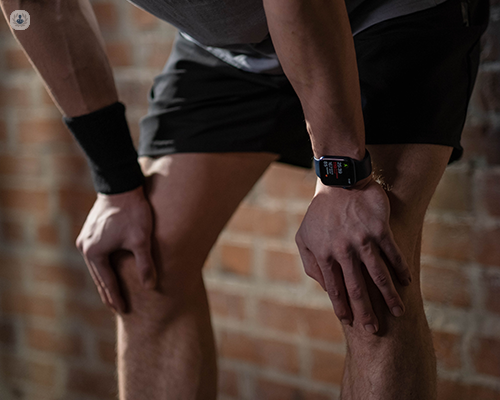Total and partial knee replacement: what’s the difference?
Written in association with:Knee pain is a common issue that affects many people, particularly as they age or engage in activities that put significant stress on the knee joint. When conservative treatments such as medications, physical therapy, and lifestyle modifications fail to alleviate the pain, surgical options like knee replacement may be considered. Knee replacement surgery, which can be either total or partial, aims to restore function and relieve pain in the damaged knee.
Leading consultant orthopaedic surgeon Mr Rahul Kakar delves into what total and partial knee replacements involve and the differences between the two.

What is a total knee replacement?
A total knee replacement (TKR) entails replacing all two/three parts of the knee joint, depending on the condition of the joints: the medial compartment (inside part), the lateral compartment (outside part), and the patellofemoral compartment (front of the knee). In this procedure, the damaged cartilage and bone are removed and substituted with metal and plastic components that mimic the movement of a natural knee.
TKR is often recommended for patients with severe arthritis or significant joint damage. This condition can lead to pain, swelling, and reduced mobility, severely impacting the quality of life. By replacing the entire joint, TKR can provide substantial pain relief and improved function.
What is a partial knee replacement?
Partial knee replacement (PKR), also known as unicompartmental knee arthroplasty, involves replacing only the damaged portion of the knee. The knee joint is divided into three compartments, and if only one of these is affected by arthritis or injury, PKR may be a viable option.
PKR is less invasive than TKR, as it preserves more of the patient's natural knee structure. This can result in a faster recovery, less post-operative pain, and more natural knee movement. However, not all patients are suitable candidates for PKR; it is typically considered for those with localised damage and healthy ligaments.
Who is a candidate for knee replacement surgery?
Candidates for knee replacement surgery typically experience severe knee pain or stiffness that limits daily activities, including walking, climbing stairs, and getting in and out of chairs. Other criteria include chronic knee inflammation and swelling that does not improve with rest or medications, and knee deformity.
Before recommending knee replacement surgery, your orthopaedic surgeon will assess your condition using a combination of physical examinations, imaging studies like X-rays, and your medical history. They will consider factors such as the severity of your symptoms, the extent of the knee damage, your age, overall health, and activity level.
What does recovery involve?
Recovery from knee replacement surgery varies depending on whether you undergo TKR or PKR. Typically, PKR patients experience a quicker recovery due to the less invasive nature of the surgery. Rehabilitation exercises and physical therapy are crucial components of the recovery process for both types of surgery.
Most of Mr Kakar's patients can expect to go home the next day, post-surgery. Physical therapy usually begins immediately, focusing on regaining movement and strengthening the muscles around the knee. Most patients can resume normal activities within 6 to 12 weeks, although full recovery may take up to a year.
What are the risks and benefits?
Both TKR and PKR carry risks, including infection in less than 1%, blood clots, implant loosening, persistent pain, fracture and revision surgery. However, these risks are relatively low and the benefits often outweigh them. The primary benefits include significant pain relief, improved mobility, and enhanced quality of life.
If you are considering knee replacement surgery and would like to book a consultation with Mr Kakar, simply visit his Top Doctors profile today.


